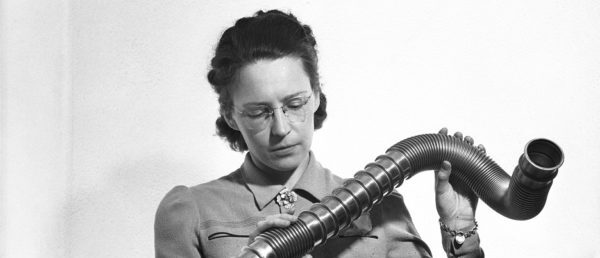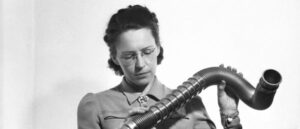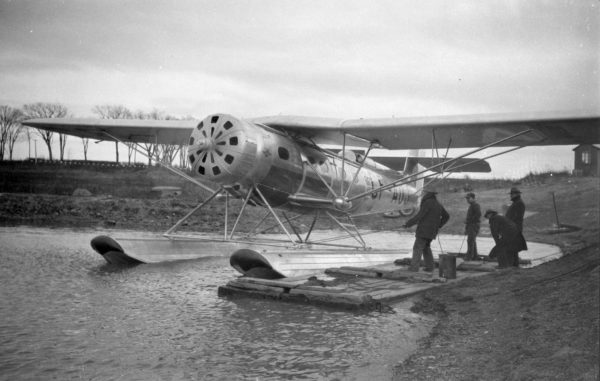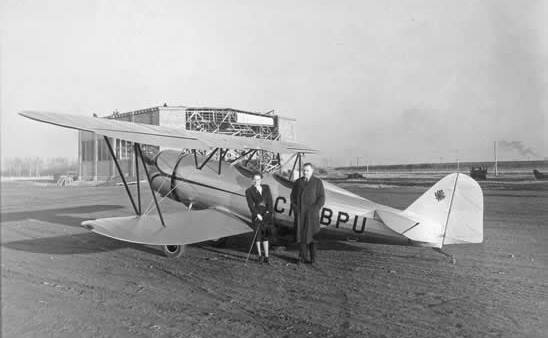- Subscribe to my newsletter! Click here →
Elsie MacGill

 Dot and Dash Wilson were two fictional WW2 heroes from Canada, but there were real ones as well. Elsie MacGill was an amazing woman, and she deserved her own little page here.
Dot and Dash Wilson were two fictional WW2 heroes from Canada, but there were real ones as well. Elsie MacGill was an amazing woman, and she deserved her own little page here.
Elizabeth Muriel MacGill, nicknamed “Elsie”, a.k.a. the “Queen of the Hurricanes” was born in 1905 in Vancouver, BC (Canada) and was the first woman to ever be admitted to the University of Toronto’s engineering programme. After graduation in 1927, Elsie became the first woman in Canada to graduate with a degree in electrical engineering. In 1929, she earned a master’s degree in aeronautical engineering from the University of Michigan then worked with an automobile company in Pontiac, Michigan as a mechanical engineer, focusing on stress analysis in automobiles. While there, she began studying aeronautics, and she soon graduated from the University of Michigan as the world’s first female aeronautical engineer.
But just before her graduation ceremony, twenty-four-year-old Elsie fell very ill and was diagnosed with polio.
Poliomyelitis, also called “The Crippler”, was a horrible, infectious disease that struck Canada hard. Effects could be mild, or the disease could attack motor neurons in the spinal cord, causing muscle weakness or paralysis. It could and did paralyze lungs, severely affecting breathing. Extreme cases had to be treated in an ‘Iron Lung’, a coffin-sized, metal box attached to bellows. The bellows’ constant suction forced air into lungs that could not function on their own, allowing the patient to breathe. The disease peaked in 1953 with almost 9,000 cases across Canada, resulting in 494 deaths. Scientists at the Connaught Laboratories at the University of Toronto (today known as Sanofi Pasteur Canada) were essential to creating the polio vaccine, producing it on a large scale, then exporting it for global polio eradication. Because of that initiative, the world has gone from handling 300,000 cases in 1988 to fewer than forty today.
Doctors told Elsie that she would never walk again, but they evidently didn’t know her determined character. She returned home to Vancouver and convalesced there for three years, writing various articles on aviation and women’s rights. She learned to walk again with crutches, then she went on to take advanced studies in aeronautics at M.I.T.
In 1934, despite the world being deep into the Great Depression, she was offered a job working as an engineer at Fairchild (Canada) Aircraft Ltd, where she helped develop Canada’s producing FC-super 71 (pictured below) and FC-82 bush planes that were particularly well-suited to the temperatures and conditions in northern Canada . Due to her disability, she could no longer fly, but she participated in test flights.

Fairchild Canada Super 71
Four years later, the Canadian Car & Foundry in Fort William (now Thunder Bay), Ontario hired Elsie as chief engineer, where she redesigned a training biplane, creating the CCF Maple Leaf II (pictured below), the first aircraft in the world designed by a woman.

Elsie MacGill posing in front of her CCF Maple Leaf II
But then another contract came in, and this time it was a really big one. The RAF needed Hawker Hurricanes to take on the German Luftwaffe, and Elsie was given the task of setting up an assembly line, then managing 4,500 workers (half of them women) in the construction of the production of 1451 Hurricanes. Along the way, Miss MacGill added a few of her own extras to the airplanes, including skis and de-icing controls. ‘CanCar’, as it was also called, became home to the Canadian version of “Rosie the Riveter”, the US cultural icon used to recruit women to work for the war effort. Canada’s National Film Board made a short, delightful documentary about our, “Rosies of the North” (https://www.nfb.ca/film/rosies_of_the_north/) in which some of the women return to the factory sixty years later. I love the first sentence of the film’s description: “They raised children, baked cakes… and built world-class fighter planes.”
In 1942, American True Comics published a comic strip about her, crowning her “Queen of Hurricanes”. 
In 1943, CanCar shifted their attention to producing the brand new SB2C Helldiver (dive bomber). Without explanation or justification, both Elsie and plant manager E. J. Soulsby were fired. Eventually, it was revealed that Elsie and E.J. were having a romantic affair, so the firing was intended to avoid scandal. Nothing had ever failed for Elsie before, and little moral questions like that one weren’t about to stop her. They moved to Toronto and got married a few weeks later. Elsie founded a highly successful aeronautical engineering consulting firm, and in 1946 she helped establish the International Civil Aviation Organization (ICAO) in Montreal in 1946.
Elsie was also a leading figure in Canada’s feminist movement, campaigning for gender equality and women’s right to abortion. Twenty-on years later, in 1967, she was appointed by the federal government to sit on the Royal Commission on the Status of Women in Canada. She became a Member of the Order of Canada in 1971, and in 1980, she was inducted into Canada’s Aviation Hall of Fame.

